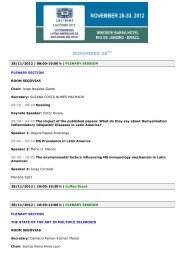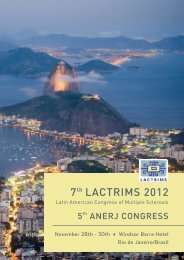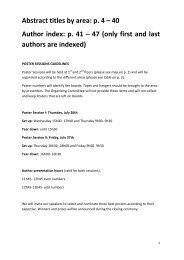Keynote Conference - Interevent
Keynote Conference - Interevent
Keynote Conference - Interevent
You also want an ePaper? Increase the reach of your titles
YUMPU automatically turns print PDFs into web optimized ePapers that Google loves.
Symp#5 Host Parasite Interaction<br />
Chair Wanderley de Souza<br />
Wanderley de Souza<br />
Federal University of Rio de Janeiro (UFRJ), Rio de Janeiro, Brazil<br />
Introductory Notes<br />
Dephosphorylation of eIF5A is Required for Translation Arrest at the Stationary Growth Phase of Trypanosoma cruzi<br />
Chung, J.*; Rocha, A. A.*, Tonelli, R. R.;,Castilho, B. A., and Sérgio Schenkman.<br />
Departamento de Microbiologia, Imunologia e Parasitologia, Universidade Federal de São Paulo, São Paulo, Brazil<br />
* Both authors contributed equally<br />
The protein known as eukaryotic initiation factor 5A (eIF5A) has an elusive role in the translation elongation. It has a unique and<br />
essential hypusine modification on a conserved lysine residue in most eukaryotes. In addition, this protein is modified by<br />
phosphorylations with unknown functions. Here we found that a phosphorylated state of eIF5A from Trypanosoma cruzi (TceIF5A),<br />
the protozoan that causes Chagas’ disease, predominates in exponentially growing cells and extensive dephosphorylation occurs in<br />
cells reaching the stationary growth phase. The phosphorylation was shown to occur mainly at Ser 2, then at Ser 47, homologous to<br />
yeast eIF5A. In addition, a novel phosphorylation site was identified at Tyr 21. In exponential cells, TceIF5A is partially associated with<br />
polysomes, compatible with its function as an elongation factor and become relatively enriched in polysomal fractions at stationary at<br />
stationary phase. TceIF5A overexpression increases the rate of cell proliferation, protein synthesis, and the relative amount of<br />
polysomes. When Ser 2 is replaced by Asp, but not by Ala, in the overexpressors, the cells still show an increased protein synthesis<br />
and growth rate. However, the presence of Asp causes cell damage when cultures reach the stationary phase. Wild type, or Ala, but<br />
not Asp replacing Ser 2 forms of TceIF5A causes protein synthesis arrest and are enriched in polysomal content at the stationary<br />
phase. We conclude that dephosphorylation of eIF5A has a key role in arresting the protein synthesis under unfavorable conditions,<br />
indicating that eIF5A phosphorylation/dephosphorylation might control its association with polysomes during translation elongation.<br />
Ion Regulation in the Malaria Parasite: The Target of a New Generation of Antimalarials<br />
Kiaran Kirk<br />
Research School of Biology, The Australian National University, Canberra, ACT, 0200, Australia<br />
The intraerythrocytic malaria parasite induces novel channels in the membrane of its host erythrocyte. These channels mediate the<br />
uptake of essential nutrients but, at the same time, allow a net influx of Na + ions, resulting in an elevated Na + concentration in the<br />
host cell compartment. The intraerythrocytic malaria parasite itself maintains an intracellular Na + concentration some ten-fold less<br />
than that in its host cell, extruding Na + via a Na + -ATPase on its plasma membrane. Bioinformatic analysis of the genome of the human<br />
malaria parasite Plasmodium falciparum reveals that the most likely candidate for the parasite’s Na + ATPase is a protein known as<br />
PfATP4.<br />
The spiroindolones are a new class of compound that inhibit the in vitro growth of the human malaria parasite, Plasmodium<br />
falciparum, at nanomolar concentrations. One of the spiroindolones is now in Phase IIa clinical trials, and is the first molecule with a<br />
novel mechanism of action to enter Phase IIa studies for malaria in the last 20 years. Prolonged exposure of P. falciparum parasites to<br />
sub-lethal concentrations of spiroindolones leads to the emergence of spiroindolone-resistant parasites, with the resistance<br />
attributable to mutations in PfATP4. In this talk I will introduce the cell physiology of the intracellular malaria parasite and present<br />
evidence that the spiroindolones exert their antimalarial effect by inhibiting Na + extrusion via PfATP4, thereby disrupting Na +<br />
regulation in the intracellular parasite.<br />
Why coinfect cells with non-viral pathogens?<br />
Michel Rabinovitch<br />
Universidade Federal de São Paulo – Escola Paulista de Medicina, Departamento de Microbiologia, Imunologia e Parasitologia, São<br />
Paulo, Brazil e-mail: michel.rabinovitch3@gmail.com<br />
Coinfection of E. coli bacteria with mutant bacteriophages in the 1940s spurred the development of molecular virology. Beginning in<br />
the 1960s, virologists, among them alumni of the CSHL Phage Course, coinfected mammalian cells with virus mutants, strains or<br />
species and developed the basic procedures and concepts of viral genetics. The AIDS pandemic of the 1980s begot cell coinfections of<br />
HIV and non-viral pathogens. In the 1990s, impressive horizontal gene exchanges were detected between pathogens sheltered in<br />
free-living protozoa. In contrast, there are few reports–briefly reviewed in the presentation-of mammalian cells coinfected with<br />
bacteria or protozoa. Initially, the model permitted the targeting of pathogens to intracellular compartments they normally don’t<br />
occupy, thanks to C. burnetii’s exceptionally large and hospitable parasitophorous vacuoles. Vacuolar colocalization will probably be<br />
rare in the world of coinfections. We believe that coinfection, apart from its ludic quality, may uncover unexpected, and hopefully<br />
interesting, interactions involving (for instance), antagonism via secreted toxins or antibiotics, competition for cell derived nutrients,<br />
quorum sensing effects, exploitable modulation of host cell gene expression and transduction cascades. We thus argue that<br />
coinfection with non-viral-pathogens could provide an added tool for mono-infection-entrenched cellular microbiologists. However,<br />
whereas mono-infections may reflect a dialogue – by proxy - between two genomes, the neo-coinfector may be confronted with a<br />
livelier dialogue involving three – genomes, besides the potential participation of a fourth, the host cell mitochondrial genome. One<br />
problem remains: given the number of available microorganisms, how is one to select the most promising pair for coinfection?<br />
57





